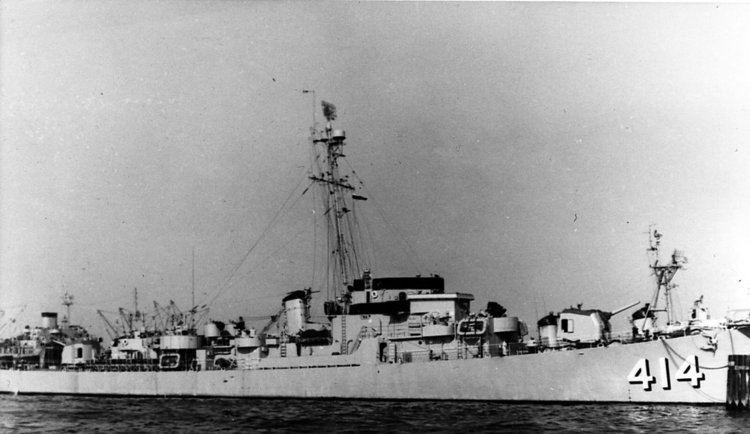Name LeRay Wilson Laid down 20 December 1943 Decommissioned 15 January 1947 Construction started 20 December 1943 Length 93 m | Namesake LeRay Wilson Commissioned 10 May 1944 Recommissioned 28 March 1951 Launched 28 January 1944 | |
 | ||
Builders | ||
USS LeRay Wilson (DE-414) was a John C. Butler-class destroyer escort acquired by the U.S. Navy during World War II. The primary purpose of the destroyer escort was to escort and protect ships in convoy, in addition to other tasks as assigned, such as patrol or radar picket. Post-war she returned home proudly with four battle stars to her credit.
Contents
She was named in honor of LeRay Wilson who was awarded the Silver Star for his bravery under attack by Japanese aircraft. The ship's keel was laid down on 20 December 1943 by Brown Shipbuilding Co. at their yard in Houston, Texas. LeRay Wilson was launched on 28 January 1944; sponsored by Mrs. Julia Wilson, mother of LeRay Wilson and commissioned on 10 May 1944, Lt. Comdr. M. V. Carson in command.
World War II
After shakedown off Bermuda, the new destroyer escort departed Boston, Massachusetts, 15 July 1944 for the Pacific war zone. With calls at San Diego, California, Pearl Harbor, and Eniwetok, LeRay Wilson arrived at Manus in Admiralty Islands, as the Navy prepared for the invasion of the Philippines. Departing 12 October, she escorted Task Force 77.4.2 to Leyte, arriving 18 October. For the next 12 days, the destroyer escort remained on station screening Rear Admiral Felix Stump's escort carriers while they repelled the attacking Japanese fleet and provided air cover for the landings. The ship arrived at Manus on 3 November and returned to the battle from 20 to 28 November, escorting more carriers to provide air cover for the enemy-infested convoy lanes east and southeast of Leyte.
With Leyte secured, the destroyer escort immediately became involved in the Lingayen Gulf operation. While on antisubmarine patrol near the western entrance to Lingayen Gulf on 10 January 1945, LeRay Wilson underwent Japanese kamikaze attacks. Spotting an enemy two-engine bomber dead ahead about 25 feet (7.6 m) off the water, the ship’s gunners maintained continuous gunfire, diverting the aircraft enough to save the ship. As the plane splashed, its starboard wing crashed the ship’s port side, killing six gunners, seriously wounding seven more, and causing extensive damage. LeRay Wilson continued patrolling until relieved later the same day, then steamed for Manus. In his battle report Lt. Comdr. M. V. Carson, commanding officer, wrote of the crew: “I say that those men made naval tradition. May their gallant acts live always in the memory of a grateful nation....They were my shipmates and I am proud of them.”
During February and March 1945, the ship repaired its port side and prepared for the largest operations of the Pacific war, the capture and occupation of Okinawa. During April, she escorted two convoys of supply ships from Saipan to Okinawa. On 1 May LeRay Wilson began antisubmarine and antiaircraft screening duties off Okinawa. On 26 May she detected and made runs on a midget submarine. Two days later, quick action from the destroyer escort splashed an enemy kamikaze before it could crash into a sister ship. She departed Okinawa on 16 June and arrived Ulithi on 26 June.
For the remainder of the war, LeRay Wilson supported the strikes on the Japanese homeland, escorting oilers and other logistics ships to rendezvous with Admiral William Halsey’s 3rd Fleet in the East China Sea. After the Surrender of Japan, she steamed to Tokyo Bay for occupation duty.
The ship departed Tokyo Bay 12 October for Okinawa en route to duty along the coast of China, remaining there until she sailed 26 December for San Francisco, California, arriving 16 January 1946 and joining the Pacific Reserve Fleet. LeRay Wilson decommissioned on 15 January 1947.
Korean War and fate
With the advent of the Korean War and the need for more fighting ships, LeRay Wilson recommissioned on 28 March 1951. After 2Template:Frac1 years of training and patrol duty between the U.S. West Coast and Pearl Harbor, the ship departed Pearl Harbor on 27 August 1954 for the first of four WestPac cruises. LeRay Wilson continued these missions to the Far East until she decommissioned at San Diego on 30 January 1959 and reentered the Pacific Reserve Fleet. On 15 May 1972 she was struck from the Navy list, and, on 14 September 1973, she was sold for scrap and broken up.
Awards
LeRay Wilson received four battle stars for World War II service.
